Ah, the eternal quest for gains. If you’ve ever stepped foot in a gym or scrolled through fitness forums, you’ve probably heard whispers about the magical effects of anabolic hormones on muscle growth. But let’s cut through the bro-science and dive into the real deal. Anabolic hormones are the body’s natural muscle-building messengers, orchestrating a symphony of cellular processes that can transform your physique from string bean to Greek god (results may vary, of course).
Key Takeaways:
- – Anabolic hormones, particularly testosterone, growth hormone, and IGF-1, play crucial roles in muscle growth and strength development.
- – Testosterone exhibits dose-dependent effects on muscle mass and performance, with both physiological and supraphysiological levels showing distinct impacts.
- – Growth hormone and IGF-1 work synergistically with testosterone to promote muscle hypertrophy and strength gains.
- – Natural hormone optimization through training, nutrition, and lifestyle factors can significantly influence muscle growth.
- – Understanding the interplay between anabolic and catabolic hormones is essential for maximizing muscle-building potential.
Table of Contents
Understanding Anabolic Hormones
Anabolic hormones are the body’s chemical messengers that stimulate tissue growth and metabolism. These powerful substances play a crucial role in muscle development, strength gains, and overall body composition. The primary anabolic hormones we’ll focus on are testosterone, growth hormone (GH), and insulin-like growth factor-1 (IGF-1).
Testosterone, often dubbed the king of anabolic hormones, is a steroid hormone primarily produced in the testes of males and, to a lesser extent, in the ovaries of females. It’s responsible for the development of male secondary sexual characteristics, but its influence extends far beyond that. Testosterone is a key player in protein synthesis, muscle fiber hypertrophy, and strength gains.
Growth hormone, secreted by the pituitary gland, is another heavyweight in the anabolic arena. It’s not a single hormone but a family of related peptides with varying biological activities. GH stimulates the production of IGF-1 in the liver and other tissues, creating a powerful anabolic duo. This hormone cocktail promotes cellular growth and metabolism, influencing everything from muscle mass to bone density.
IGF-1, primarily produced in response to GH stimulation, acts as a potent growth factor. It’s structurally similar to insulin and plays a crucial role in childhood growth and continues to have anabolic effects in adults. IGF-1 is particularly important for satellite cell activation, a key process in muscle repair and growth.
These hormones don’t work in isolation. They form a complex, interconnected system that regulates muscle growth and overall body composition. Testosterone, for instance, can enhance GH secretion, while GH and IGF-1 can increase the sensitivity of tissues to testosterone’s effects.
The basic functions of these anabolic hormones in the body are multifaceted:
- Muscle protein synthesis: They increase the rate at which muscle cells build new proteins, leading to muscle growth.
- Satellite cell activation: These hormones stimulate muscle stem cells to divide and fuse with existing muscle fibers, contributing to muscle repair and growth.
- Metabolism regulation: They influence how the body uses and stores nutrients, affecting body composition.
- Bone density: Anabolic hormones play a role in maintaining and increasing bone mass.
- Fat metabolism: They can help in mobilizing and utilizing fat stores for energy.
Understanding these hormones is crucial for anyone looking to optimize their muscle growth, whether you’re a competitive athlete, a bodybuilder, or just someone looking to improve their physique. However, it’s important to note that while these hormones are powerful, they’re just one piece of the muscle-building puzzle. Proper nutrition, consistent training, and adequate recovery are all essential components of any successful muscle growth strategy.
In the following sections, we’ll dive deeper into each of these hormones, exploring their specific effects on muscle mass, strength, and overall body composition. We’ll look at groundbreaking research that has shaped our understanding of these hormones and discuss practical applications for optimizing your own anabolic environment.

Testosterone: The Primary Player
Testosterone is the heavyweight champion of muscle growth. This powerhouse hormone plays a crucial role in building and maintaining muscle mass, making it the primary player in the anabolic arena. As a natural bodybuilder and researcher, I’ve seen firsthand how testosterone can transform physiques and performance.
Natural testosterone levels vary widely among men, typically ranging from 300 to 1000 ng/dL. These levels can significantly influence an individual’s ability to pack on muscle. However, it’s not just about having high testosterone; it’s about how your body responds to it.
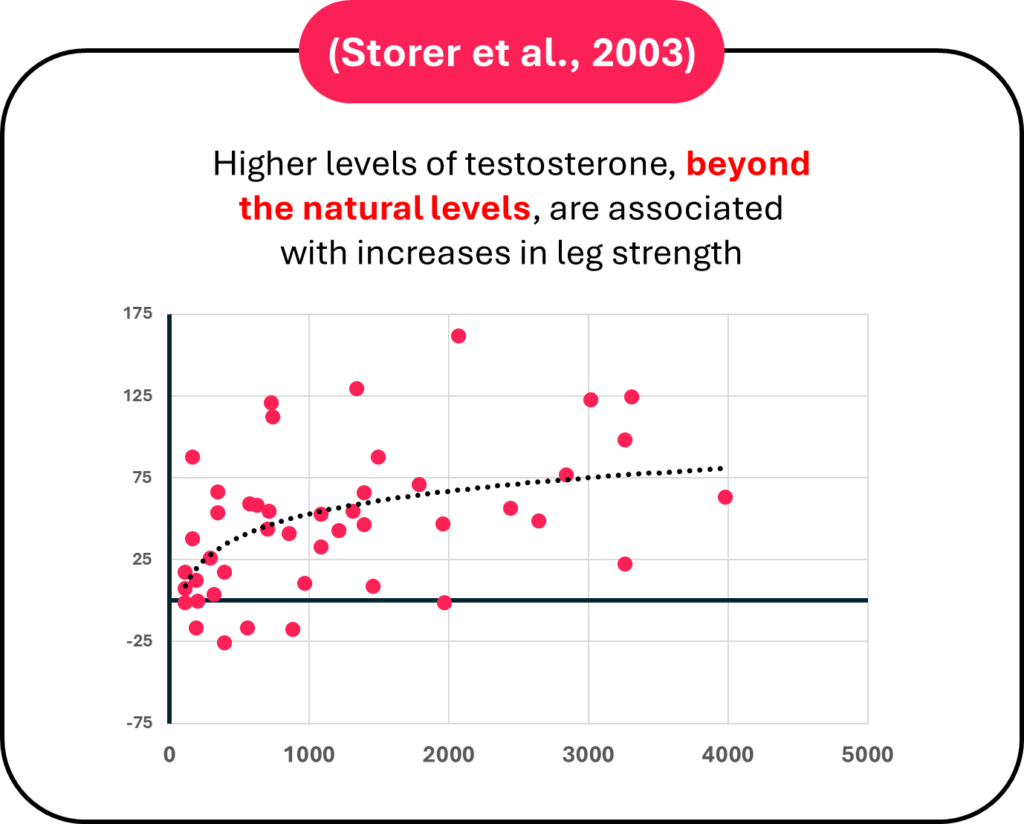
A groundbreaking study by Storer et al. (2003) shed light on the dose-dependent nature of testosterone’s effects on muscle. They found that increasing testosterone doses led to proportional increases in muscle strength and power. However, the relationship isn’t linear. It follows a log-linear pattern, meaning you get diminishing returns as you approach supraphysiological levels.
Let’s break down the numbers:
Table 1. Increase in Strength to Testosterone
| Testosterone Dose (mg/week) | Mean Total Testosterone (ng/dL) | Strength Increase |
|---|---|---|
| 25 | 253 | Minimal |
| 50 | 306 | Slight |
| 125 | 570 | Moderate |
| 300 | 1345 | Significant |
| 600 | 2370 | Maximal |
Now, before you start dreaming about superhuman strength, remember that more isn’t always better. The 300 mg and 600 mg doses in this study pushed testosterone levels well beyond the natural range. While they did result in the most significant strength gains, they also venture into the realm of potential side effects.
Additionally, it’s not just about brute strength. Testosterone’s magic extends to the cellular level. Sinha-Hikim et al. (2002) revealed that testosterone-induced muscle growth is primarily due to muscle fiber (aka muscle cell) hypertrophy. Both type I (slow-twitch) and type II (fast-twitch) muscle fibers bulked up in response to testosterone, with the most dramatic effects seen at higher doses.
Here’s where it gets interesting: the 600 mg/week group saw a whopping 1,637 μm² increase in type I fiber cross-sectional area and a 1,466 μm² increase in type II fibers. That’s like turning your muscle fibers into miniature bodybuilders!


But testosterone doesn’t work alone. It’s part of a complex hormonal symphony. As testosterone levels rise, it triggers an increase in myonuclear number. Think of myonuclei as the control centers of muscle fibers. More myonuclei mean greater potential for muscle growth and protein synthesis.
Now, before you start plotting ways to skyrocket your testosterone levels, remember that the body is all about balance. Supraphysiological testosterone levels might sound tempting, but they come with a host of potential side effects. Plus, there’s evidence that the benefits start to plateau at a certain point.
Natural Gains
For the average gym-goer looking to maximize their gains naturally, focus on optimizing your testosterone levels within the normal physiological range. This means paying attention to your diet, sleep, stress management, and training intensity. Heavy compound lifts, adequate protein intake, and sufficient rest can all contribute to a favorable hormonal environment for muscle growth.
Remember, testosterone is just one piece of the muscle-building puzzle. It works in concert with other anabolic hormones like growth hormone and IGF-1, which we’ll explore in the following sections. The key is to create an environment where all these hormones can work synergistically to help you build the physique you’re after.
In the grand scheme of muscle growth, testosterone reigns supreme. It’s the king of anabolic hormones, the maestro conducting the symphony of gains. But like any good ruler, it needs its supporting cast to truly shine. So, as we move forward, keep in mind that while testosterone is crucial, it’s just the beginning of our hormonal journey into the world of muscle mass.
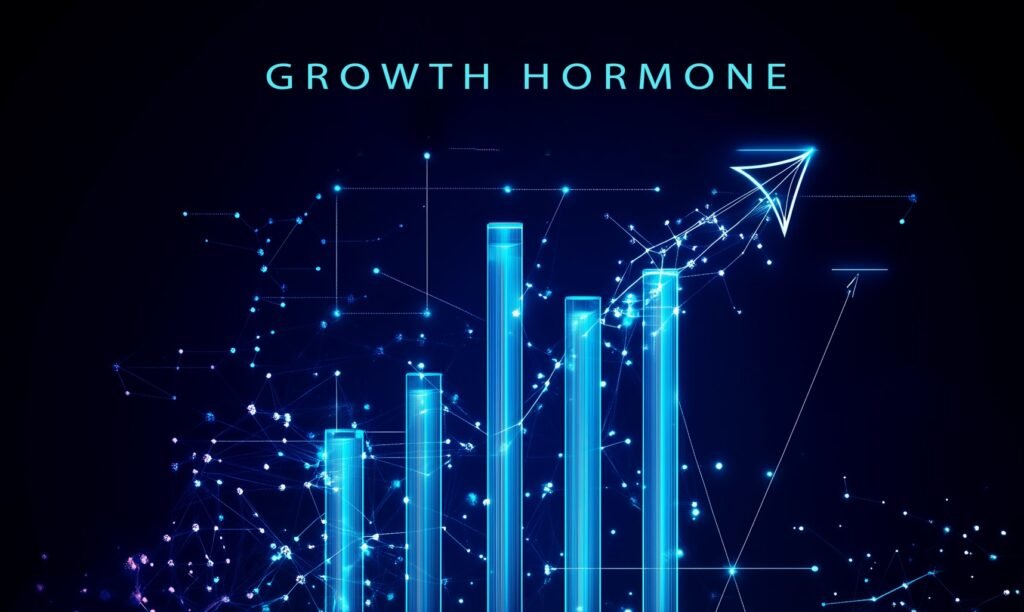
Growth Hormone (GH) and Muscle Mass
Growth hormone (GH) plays a crucial role in muscle growth and development. This peptide hormone, secreted by the anterior pituitary gland, isn’t just a single entity but a complex family of related hormones. Each variant has its own biological activity and impact on muscle tissue.
The 22 kDa monomeric form of GH is the most well-known, but it’s not the only player in the game. Larger aggregates and other isoforms also contribute to the overall anabolic effect. This diversity in GH molecules is part of what makes studying its effects so challenging and fascinating.
GH exerts its anabolic effects through various mechanisms. It stimulates protein synthesis, enhances amino acid uptake by muscle cells, and promotes the mobilization of fat for energy. This multi-faceted approach contributes to both muscle growth and fat loss, making GH a key player in body composition changes.
One interesting aspect of GH is its storage and release mechanism. In the pituitary, GH is stored in secretory granules as an amyloid structure. This unique storage form may protect GH from degradation and allow for efficient release when needed. It’s like nature’s own time-release capsule, ensuring a steady supply of this crucial hormone.
Growth Hormone and Exercise
The relationship between GH and exercise is complex. Different types of exercise can elicit varying responses in GH release. High-intensity exercise, particularly resistance training, tends to cause acute spikes in GH levels. However, the exact relationship between these exercise-induced GH spikes and long-term muscle adaptations isn’t fully understood. It’s not as simple as “more GH equals more muscle.”
Interestingly, the pituitary gland contains two distinct populations of GH-producing cells: light and heavy somatotrophs. The heavy somatotrophs produce more bioactive GH than their lighter counterparts. This heterogeneity in GH-producing cells adds another layer of complexity to understanding GH’s role in muscle growth.
GH doesn’t work alone. It interacts closely with other anabolic hormones, particularly insulin-like growth factor-1 (IGF-1). GH stimulates the production of IGF-1 in the liver and other tissues, including muscle. This GH-IGF-1 axis is a key pathway in promoting muscle growth and repair.
While GH is often touted as a miracle hormone for muscle growth, its effects are more nuanced than many realize. Supraphysiological levels of GH, such as those seen in acromegaly or with exogenous administration, don’t necessarily translate to proportional increases in muscle mass. There’s a point of diminishing returns, and excessive GH can lead to negative health consequences.
It’s also worth noting that GH’s effects on muscle may be more pronounced in certain populations. For instance, individuals with GH deficiency often experience significant improvements in muscle mass and strength with GH replacement therapy. However, in healthy adults with normal GH levels, the benefits of additional GH for muscle growth are less clear-cut.
Table 2. Growth Hormone Effects on Muscle Mass
| GH Characteristic | Description | Impact on Muscle Mass |
|---|---|---|
| Molecular Diversity | Multiple isoforms and aggregates | Different forms may have varying anabolic potency |
| Storage Mechanism | Amyloid structure in secretory granules | Efficient release for muscle growth stimulation |
| Somatotroph Types | Light and heavy somatotrophs | Heavy somatotrophs produce more bioactive GH |
| Exercise Response | Varies by exercise type and intensity | Acute GH spikes may contribute to long-term adaptations |
| IGF-1 Interaction | Stimulates IGF-1 production | Enhances overall anabolic environment |
In conclusion, while GH is undoubtedly important for muscle growth, its role is complex and intertwined with other hormonal and cellular processes. Understanding these intricacies is crucial for optimizing training and nutrition strategies aimed at muscle hypertrophy. As research continues to unravel the mysteries of GH and its variants, we may discover new ways to harness its anabolic potential safely and effectively.

Insulin-Like Growth Factor-1 (IGF-1)
Insulin-Like Growth Factor-1 (IGF-1) is a crucial player in the muscle growth orchestra. This hormone, structurally similar to insulin, acts as a potent anabolic agent, stimulating protein synthesis and inhibiting protein breakdown. While testosterone might be the headliner, IGF-1 is the unsung hero working behind the scenes to promote muscle hypertrophy.
IGF-1’s relationship with muscle growth is complex and multifaceted. It doesn’t just stimulate muscle protein synthesis; it also enhances satellite cell activation and proliferation. These satellite cells are essential for muscle repair and growth, fusing with existing muscle fibers to increase their size and strength. Think of IGF-1 as the foreman on a construction site, directing the workers (satellite cells) to build and repair the muscle tissue.

One of the fascinating aspects of IGF-1 is its dual origin. We have both systemic IGF-1, produced primarily in the liver in response to growth hormone, and locally produced IGF-1 within the muscle tissue itself. This local production is particularly interesting because it allows for targeted anabolic effects in response to specific stimuli, such as resistance training.
When it comes to resistance training, the IGF-1 response is not as straightforward as you might think. Acute responses of circulating IGF-1 to a single bout of resistance exercise can be variable. Some studies show increases, while others show no change or even decreases. It’s like trying to predict the weather – sometimes you get it right, sometimes you’re way off.
However, the chronic adaptations to resistance training are where things get really interesting. Regular resistance training can lead to increased local IGF-1 production within the muscle tissue. This localized increase is thought to be a key factor in the muscle’s adaptive response to training.

IGF-1 Signaling Pathway
The IGF-1 receptor and its signaling pathways are crucial for translating the hormone’s presence into actual muscle growth. When IGF-1 binds to its receptor, it kicks off a cascade of events inside the muscle cell. This includes activation of the PI3K/Akt pathway, which is a bit like turning on the muscle’s growth switch. It also triggers the MAPK pathway, which is involved in cell proliferation and differentiation.
But here’s where it gets tricky – more IGF-1 doesn’t always mean more muscle growth. The body’s response to IGF-1 can become blunted if levels are consistently elevated, a phenomenon known as IGF-1 resistance. It’s like constantly yelling at someone – eventually, they start to tune you out.
Moreover, the interplay between IGF-1 and other hormones adds another layer of complexity. For instance, testosterone can increase IGF-1 production, while cortisol can decrease it. It’s a hormonal tug-of-war, with your muscles caught in the middle.
Age also plays a role in the IGF-1 and muscle growth equation. As we get older, our IGF-1 levels naturally decline, which may contribute to age-related muscle loss (sarcopenia). This is why maintaining muscle mass becomes increasingly important as we age – we’re fighting an uphill battle against our own hormones.
In practical terms, while we can’t directly control our IGF-1 levels, we can influence them through our lifestyle choices. Regular resistance training, adequate protein intake, and good sleep hygiene can all positively impact IGF-1 production and sensitivity. Ideally, you want to give your body the best possible environment for muscle growth.
Table 3. IGF-1 Function
| Factor | Effect on IGF-1 |
|---|---|
| Resistance Training | Increases local muscle IGF-1 production |
| Protein Intake | Supports systemic IGF-1 levels |
| Sleep Deprivation | Decreases IGF-1 production |
| Aging | Gradual decline in IGF-1 levels |
| Chronic Stress | Can decrease IGF-1 sensitivity |
Understanding the role of IGF-1 in muscle growth is crucial for anyone looking to optimize their training and nutrition. While it’s just one piece of the anabolic puzzle, it’s a piece that shouldn’t be overlooked. By focusing on lifestyle factors that support healthy IGF-1 function, we can set the stage for optimal muscle growth and maintenance throughout our lives.
Natural vs. Artificial Hormone Manipulation
Let’s dive into the juicy world of hormone manipulation. It’s like playing God with your endocrine system, but with potentially less smiting and more bicep curls.
First off, artificial hormone therapy isn’t a walk in the park. Sure, injecting yourself with testosterone might sound like a shortcut to Swoleville, but it comes with a side of risks that’ll make your testicles shrink faster than your gym crush’s interest when you start talking about your protein powder collection.
Risks of hormone therapy include:
- Acne that’ll make you look like a pepperoni pizza
- Male pattern baldness (because who needs hair when you’ve got gains, right?)
- Mood swings that’ll make a teenager look stable
- Cardiovascular issues that’ll have your heart working harder than you do on leg day
On the flip side, for those with clinically low testosterone, hormone replacement therapy can be a game-changer. Think of it like giving Popeye his spinach, but with more needles and less cartoon physics.

Natural Ways to Boost Testosterone
Now, let’s talk natural methods to optimize your hormone levels. It’s not as sexy as jabbing yourself with a needle, but it’s a lot less likely to turn you into a walking side effect.
- Lift heavy things: Resistance training is like a love letter to your endocrine system. It tells your body, “Hey, we need more of that good stuff to build muscle!”
- Sleep like you’re in a coma: Aim for 7-9 hours of quality shut-eye. Your body produces most of its testosterone while you’re counting sheep.
- Eat like a caveman on steroids: Lots of protein, healthy fats, and enough carbs to fuel your workouts. Your body needs raw materials to make hormones.
- Manage stress: Chronic stress is like kryptonite for your testosterone levels. Meditate, do yoga, or punch a pillow – whatever works for you.
- Supplement smartly: Zinc, magnesium, and vitamin D are like the Three Musketeers of testosterone production. Just don’t expect miracles from a pill bottle.
Now, let’s address the elephant in the room – ethical considerations in sports and bodybuilding. Using artificial hormones in competitive sports is like bringing a gun to a knife fight. It’s not just unfair; it’s downright cheating.
In bodybuilding, it’s a bit of a grey area. Many top-level bodybuilders use performance-enhancing drugs, but that doesn’t make it right or safe. It’s like comparing apples to oranges that have been injected with apple steroids.
For the average Joe (or Jane) looking to build muscle, natural is the way to go. It might be slower, but it’s safer, sustainable, and won’t turn your internal organs into a science experiment.
Remember, there’s no shortcut to Gainzville that doesn’t come with a hefty toll. Focus on optimizing your natural hormone production, and you’ll be amazed at what your body can achieve. Plus, you get to keep your hair and your dignity. Win-win!
Table 4. Ethical Considerations of Artificial Testosterone Administration
| Method | Pros | Cons |
|---|---|---|
| Natural Optimization | Safe, sustainable, legal | Slower results, requires consistency |
| Artificial Manipulation | Rapid muscle growth, increased strength | Health risks, potential legal issues, ethical concerns |
In the end, the choice between natural and artificial hormone manipulation is like choosing between a slow-cooked, perfectly seasoned steak and a microwaved burger. Sure, the burger is faster, but do you really want to put that in your body?
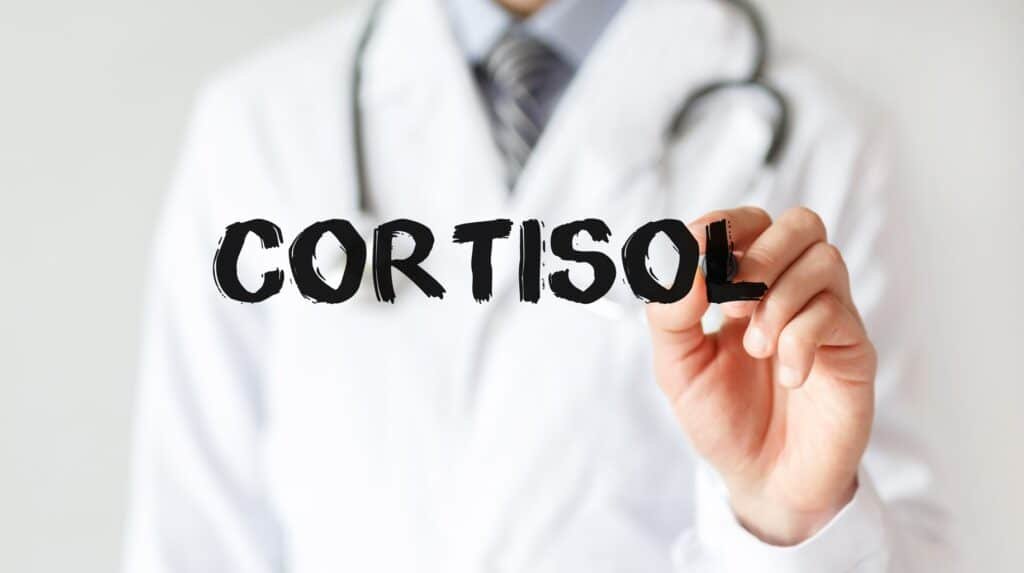
The Role of Cortisol: A Catabolic Counterbalance
While we’ve been riding the anabolic wave, it’s time to crash into the shore of reality. Enter cortisol, the party-pooper of the hormone world. This stress hormone is like that one friend who always reminds you of your responsibilities when you’re having a good time. Necessary, but sometimes a real buzzkill.
Cortisol, often dubbed the “stress hormone,” plays a crucial role in regulating various bodily functions, including metabolism, immune response, and yes, muscle mass. It’s not all bad news, though. Cortisol is essential for life, helping us wake up in the morning and respond to stressful situations. But when it comes to building muscle, cortisol is the yin to testosterone’s yang.
Let’s break it down. Cortisol is a catabolic hormone, meaning it breaks down molecules into smaller units. In the context of muscle, this translates to protein breakdown. When cortisol levels are chronically elevated, it can lead to muscle wasting, reduced protein synthesis, and increased fat storage. Think of trying to build a sandcastle while someone keeps kicking it down.
The relationship between cortisol and muscle mass is complex. Short-term elevations in cortisol, such as those experienced during intense exercise, can actually be beneficial. They help mobilize energy sources and can even enhance performance. It’s the chronic elevation that’s the real problem.
Interestingly, cortisol follows a circadian rhythm, peaking in the early morning and reaching its lowest levels around midnight. This rhythm can be disrupted by factors like stress, poor sleep, and certain medications. Maintaining a healthy cortisol rhythm is crucial for optimizing muscle growth and overall health.
The Complexity of Cortisol
But here’s where it gets tricky. Cortisol doesn’t work in isolation. It interacts with other hormones, including our muscle-building friends testosterone and growth hormone. High cortisol levels can suppress testosterone production and interfere with growth hormone secretion. It’s like cortisol is the chaperone at the anabolic hormone dance, keeping everyone at arm’s length.
So, what’s a muscle-hungry individual to do? Balance is key. While we can’t eliminate cortisol (nor should we want to), we can take steps to manage its levels:
- Stress management: Chronic stress is a one-way ticket to Cortisol City. Techniques like meditation, deep breathing, and regular exercise can help keep stress in check.
- Sleep optimization: Poor sleep is a cortisol booster. Aim for 7-9 hours of quality sleep per night. Your muscles will thank you.
- Smart training: Overtraining can lead to chronically elevated cortisol levels. Incorporate adequate rest and recovery into your training program.
- Nutrition: A balanced diet with adequate protein, carbohydrates, and healthy fats can help regulate cortisol levels. Avoid excessive calorie restriction, which can spike cortisol.
- Timing is everything: Given cortisol’s natural rhythm, some research suggests that training later in the day, when cortisol levels are naturally lower, might be beneficial for muscle growth.
It’s worth noting that the glucocorticoid receptor (GR) plays a crucial role in mediating cortisol’s effects. Recent research has identified two main isoforms of this receptor: GRα and GRβ. While GRα mediates most of cortisol’s actions, GRβ acts as a negative regulator. This complex interplay adds another layer to our understanding of cortisol’s impact on muscle mass.
Table 5. Cortisol’s Impact on Muscle Mass
| Cortisol Level | Potential Impact on Muscle Mass |
|---|---|
| Acute Elevation | Can enhance performance and mobilize energy |
| Chronic Elevation | May lead to muscle wasting and reduced protein synthesis |
| Normal Rhythm | Supports overall health and muscle maintenance |
| Suppressed | Can lead to fatigue and poor recovery |
Remember, while we often villainize cortisol in the context of muscle building, it’s an essential hormone for overall health. The goal isn’t to eliminate cortisol but to maintain a healthy balance. It’s like seasoning in cooking – the right amount enhances the dish, but too much can ruin it.
In the grand orchestra of hormones, cortisol plays a vital role. Understanding its function and learning to manage its levels can make the difference between a body that’s breaking down and one that’s building up. So next time you’re stressing about your gains, take a deep breath. Your cortisol levels will thank you, and your muscles might just grow a little bigger.

Practical Applications for Muscle Growth
Alright, let’s cut through the scientific jargon and get to the meat of what you’re here for – how to actually use this knowledge to pack on some serious muscle. Trust me, I’ve been in the trenches, both as an athlete and a researcher, and I’ve seen what works and what’s just bro-science nonsense.
First off, let’s talk training. If you want to optimize your hormone response, you need to hit the weights hard and heavy. I’m talking compound movements that recruit multiple muscle groups. Squats, deadlifts, bench presses – these are your bread and butter. Why? Because these exercises stimulate the greatest release of testosterone and growth hormone. In one study, participants who performed heavy resistance training saw a significant spike in testosterone levels post-workout.
However, it’s not just about lifting heavy. The volume of your training matters too. Aim for 3-4 sets of 6-12 reps for most exercises. This sweet spot has been shown to maximize the anabolic hormone response. And don’t forget about rest periods. Keep them short, around 60-90 seconds between sets, to maintain elevated hormone levels throughout your workout.
Now, let’s talk nutrition. You can’t build a house without bricks, and you can’t build muscle without proper fuel. Protein is crucial, aim for about 1.6-2.2 grams per kilogram of body weight daily. But don’t neglect carbs and fats. Carbs help replenish glycogen stores and can boost insulin levels, which works synergistically with other anabolic hormones. Healthy fats, especially monounsaturated and omega-3 fatty acids, are essential for hormone production.
Here’s a quick breakdown of macronutrient ratios that I’ve found effective:
Table 6. Macronutrients
| Macronutrient | Percentage of Total Calories |
|---|---|
| Protein | 25-35% |
| Carbohydrates | 40-50% |
| Fats | 20-30% |
But it’s not just about what you eat, it’s when you eat. Timing your meals around your workouts can make a big difference. Try to consume a meal containing both protein and carbs within 30 minutes after your workout. This can help capitalize on the post-exercise anabolic window (yes, I do believe in the anabolic window despite what some research suggest).
Sleep is another crucial factor that often gets overlooked. Lack of sleep can wreak havoc on your hormone levels. Aim for 7-9 hours of quality sleep per night. During deep sleep stages, your body releases the majority of its daily growth hormone. Skimp on sleep, and you’re leaving gains on the table.
Stress management is also key. Chronic stress can elevate cortisol levels, which, as we’ve discussed, can be catabolic to muscle tissue. Find stress-reduction techniques that work for you – meditation, yoga, or even just regular leisure activities can help keep cortisol in check.
For those of you getting a bit long in the tooth (no offense), consider natural testosterone boosters. I’m not talking about those sketchy pills you see advertised late at night. I mean lifestyle changes and specific nutrients. Vitamin D, zinc, and magnesium have all been shown to support healthy testosterone levels. And don’t forget about resistance training – it becomes even more important as you age to maintain muscle mass and hormone levels.
Lastly, consistency is key. Your body responds to the demands you place on it consistently over time. One hardcore workout won’t turn you into Arnold overnight, but consistent, progressive training coupled with proper nutrition and recovery will yield results.
Remember, while manipulating your hormone levels through lifestyle and training can certainly help, it’s not a magic bullet. Genetics, age, and overall health all play a role. Focus on what you can control, be patient, and the gains will come. And if they don’t, well, there’s always the option of becoming a powerlifter – those guys don’t care about aesthetics anyway, right? (I’m kidding, please don’t come after me, powerlifters!)
Conclusion
The intricate dance of anabolic hormones in muscle growth is a testament to the complexity of human physiology. Testosterone, growth hormone, and IGF-1 form a powerful trio, each playing a crucial role in the development and maintenance of muscle mass. The research we’ve explored paints a clear picture: these hormones are not just important, they’re essential for anyone looking to pack on serious muscle.
Let’s not kid ourselves, though. While the allure of supraphysiological hormone levels might be tempting for some, it’s a path fraught with risks. The studies we’ve dissected show that yes, more testosterone can indeed mean more muscle – but at what cost? It’s not just about getting big; it’s about staying healthy in the process.
For the average Joe (or Jane) looking to build muscle, the key takeaway is this: focus on optimizing your natural hormone production. This means smart training, proper nutrition, adequate sleep, and stress management. These factors can significantly influence your hormonal milieu without the need for exogenous supplementation.
Remember, cortisol isn’t the villain it’s often made out to be. It’s a necessary player in the hormonal orchestra, keeping things in check. The goal isn’t to eliminate cortisol but to maintain a healthy balance with our anabolic friends.
In the end, building muscle is a marathon, not a sprint. It requires patience, consistency, and a holistic approach to health. By understanding the role of anabolic hormones, we can make informed decisions about our training and lifestyle choices. So, hit the gym, eat your protein, and let your body do what it does best – grow stronger and more resilient, one hormone-fueled rep at a time.
References
Cigarrán, S., Pousa, M., Castro, M. J., González, B., Martínez, A., Barril, G., Aguilera, A., Coronel, F., Stenvinkel, P., & Carrero, J. J. (2013). Endogenous testosterone, muscle strength, and fat-free mass in men with chronic kidney disease. Journal of Renal Nutrition: The Official Journal of the Council on Renal Nutrition of the National Kidney Foundation, 23(5), e89-95. https://doi.org/10.1053/j.jrn.2012.08.007
Glass, D. J. (2010). PI3 kinase regulation of skeletal muscle hypertrophy and atrophy. Current Topics in Microbiology and Immunology, 346, 267–278. https://doi.org/10.1007/82_2010_78
Kraemer, W. J., Ratamess, N. A., Hymer, W. C., Nindl, B. C., & Fragala, M. S. (2020). Growth Hormone(s), Testosterone, Insulin-Like Growth Factors, and Cortisol: Roles and Integration for Cellular Development and Growth With Exercise. Frontiers in Endocrinology, 11, 33. https://doi.org/10.3389/fendo.2020.00033
Nicolaides, N. C., Chrousos, G., & Kino, T. (2000). Glucocorticoid Receptor. In K. R. Feingold, B. Anawalt, M. R. Blackman, A. Boyce, G. Chrousos, E. Corpas, W. W. de Herder, K. Dhatariya, K. Dungan, J. Hofland, S. Kalra, G. Kaltsas, N. Kapoor, C. Koch, P. Kopp, M. Korbonits, C. S. Kovacs, W. Kuohung, B. Laferrère, … D. P. Wilson (Eds.), Endotext. MDText.com, Inc. http://www.ncbi.nlm.nih.gov/books/NBK279171/
Sinha-Hikim, I., Artaza, J., Woodhouse, L., Gonzalez-Cadavid, N., Singh, A. B., Lee, M. I., Storer, T. W., Casaburi, R., Shen, R., & Bhasin, S. (2002). Testosterone-induced increase in muscle size in healthy young men is associated with muscle fiber hypertrophy. American Journal of Physiology. Endocrinology and Metabolism, 283(1), E154-164. https://doi.org/10.1152/ajpendo.00502.2001
Storer, T. W., Magliano, L., Woodhouse, L., Lee, M. L., Dzekov, C., Dzekov, J., Casaburi, R., & Bhasin, S. (2003). Testosterone Dose-Dependently Increases Maximal Voluntary Strength and Leg Power, but Does Not Affect Fatigability or Specific Tension. The Journal of Clinical Endocrinology & Metabolism, 88(4), 1478–1485. https://doi.org/10.1210/jc.2002-021231

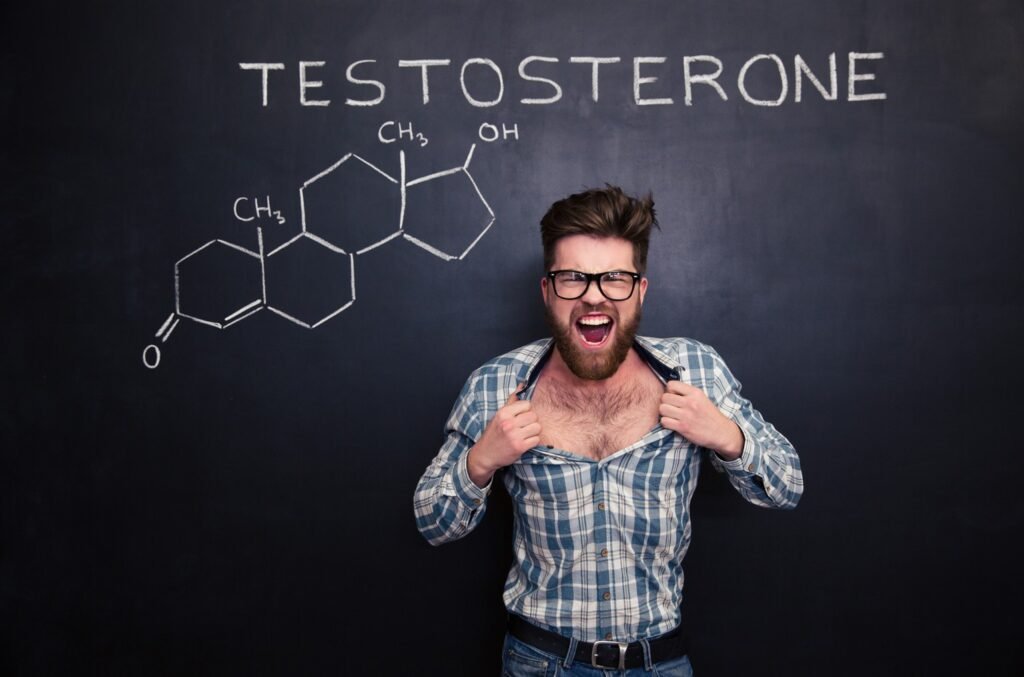
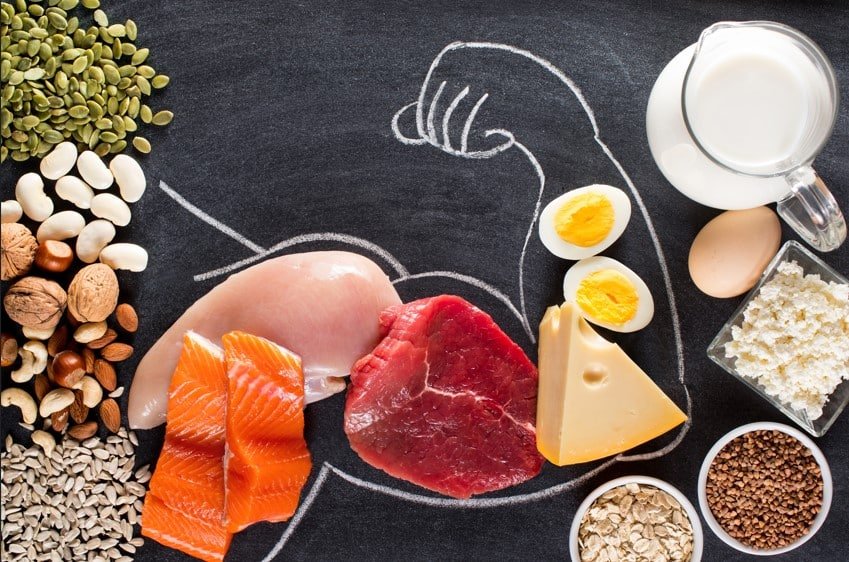

Thanks I have just been looking for information about this subject for a long time and yours is the best Ive discovered till now However what in regards to the bottom line Are you certain in regards to the supply